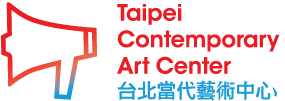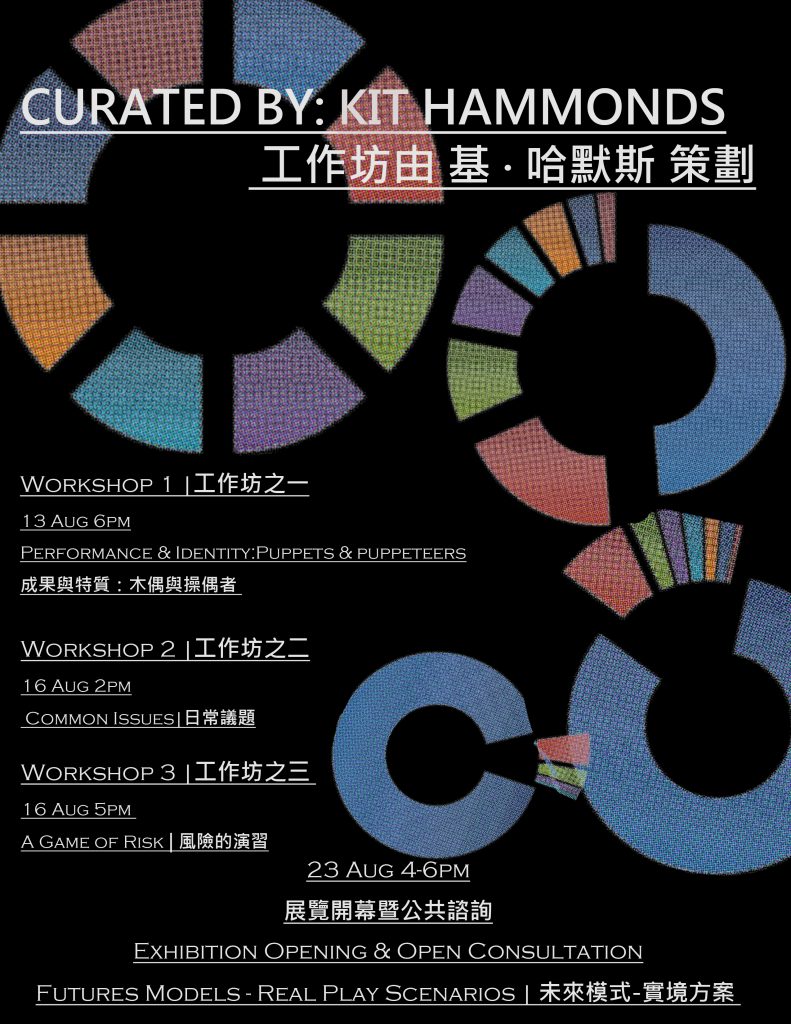2014.8.13 & 16.
The Burning Issue Residency Programme: Strategic Business plan Public Stakeholders Consultation Focus groups – Kit Hammonds
關鍵議題駐村計劃:策略商業規劃公共關係人諮商焦點小組 – 基‧哈墨斯
Wednesday, Aug 13, 6pm
工作坊之一:成果與特質:木偶與操偶者
第一場工作坊將會探討獨立藝術機構的目標和準則,特別是協會、複合式工作室及其他從業者所領導的組織。這些議題構成了一個組織的特質,並透過集體參與式的工作坊,參與者將討論:什麼是機構本身的形象?它是怎麼形成的呢?這如何展現了他們所構成的社群和公眾?並且其組織結構是否反映出這些目標?
藝術家/觀察員:王郁媜
工作坊文字記錄
文/張舒涵
Kit Hammonds為期幾週的駐村計畫開端藉木偶的意象連結三個討論要素:政府、機構、個體。操偶線向上連結公部門、向下連結木偶本身意謂機構、四肢則指向我們個人。嘗試藉「遊戲」(play)概念進行工作坊,使觀眾成為參與者,以身體參與工作坊,直接地介入討論平台。並將全體一分為二成小團,分別依題進行木偶製作與會後討論。
在有限素材與時間下呈現的木偶代表兩個「團隊」的「想像」。團隊顧名思義反應出一種多數的、具有共識的思維,勢必得經由意見的表達與討論。尤其木偶在此僅代表思維上想像的擬現。事實上,參與者試著轉化個人對機構的想像、藝術環境現實的想像、社會與個人看待藝術的想像。這些想像出發於個別的主觀意見以及相互交織成Kit口中的「木偶」。即便面對相同主題,兩組的呈現卻大相逕庭。其一實如上述般在熱烈討論後,以想像為依據建構出木偶。所選用之物件的大小、形象、距離等存在各種暗示─藝術仍是遙遠而崇高的、機構一如母體對外與公部門打交道,內部則聚集種種藝術行為,並總是處於自娛的狀態。另一方面則恰好相反。過程中討論相對較少,於基礎架構下各自為想像添加物件,甚至,對於物件的使用產生意見分歧時,能保有不認同的空間,其產出的形貌即共識下木偶的想像。特別是,組員將自己縮小成螺絲釘,進入木偶中,戴起頭套,穿起盔甲,繫上繩子,彼此相依相牽,環繞而走。利用腰間上的紅繩繫起木偶與組員兩端,亦透過木偶連繫起組員。起步繞行的同時產生了表演(perform)的概念,這由於參與者成為了作品元素之一。就表現形式而言,前者的產出傾向裝置的概念,後者隱含劇場特質於其中。
綜觀來說工作坊的角色定位,Kit是條導引線、木偶是提問也是答案、觀眾則是參與者、特殊要角─觀察員才是真正的觀察者,全覽現場狀態同時針對參與者口語表述部分,提出細膩的反饋。利用木偶指出一雙「看不見的手」,其操縱的主、被動關係,一直以來根深於體制之內,乃至社會之中。過程中,採用大量象徵性符號,試將抽象概念轉為具體指涉意義的集合物件。透過木偶,觀眾形塑的是面對提問所產生的想像,而這些想像又從觀察與討論中被堆疊而出。脫離一貫聽講模式,使參與者實質達到討論的目的,甚至推進思考的深度。
Saturday, Aug 16, 2pm
工作坊之二:日常議題
第二場工作坊將著眼於藝術空間如何交替地作為社區或連結不同族群來聚集的獨立空間。社會學家羅伯特·帕特南使用了這兩種形式的社會價值形容凝聚型與結合型社群。透過集體決策過程,有限的資源和空間可以被共享與協商。
藝術家/觀察員:王虹凱
工作坊文字記錄
文/張舒涵
前一場討論建立了機構的雛型,接著Kit將焦點轉向單位之間資源使用關係。在此提出海上島嶼的場景設定,分別代表政府、資金、藝術。島嶼彼此隔海相望,參與者必須利用各島上有限素材試圖搭起對話的橋樑。
分散於三島上的參與者關起門經兩道問題出發─想要甚麼?如何進行?再以各自立場與其他兩方做出交涉,目的達到三島連結。然而,討論過後卻幾乎無法建立起橋梁,原因何在?就政府,希望先與資金搭起單向管道,促使資金流向藝術,而藝術則產出有形與無形的社會產值,不論對政府或者社會,呈現正向的發展;就金融的討論過程中,則對府方提出各種財政措施,欲滿足其提出之要求,包括:制定法律、制度。期許資金本身是一座介於藝術和政府的中間媒介;而藝術則自顧自地搭起一艘竹筏,企圖遊走於資金和政府之間。確實彼此都完成了關係的想像連結,但,好像上述中約略透露出些許狀況端倪,故Kit在後半段的工作坊中做出了觀察上的整理。
首先,原初設計中欲以「共享」(shared)與「協商」(negotiated)的概念進行。因此,從態度層面而言,交涉的雙方立足共享的平台便不會產生所謂「交換」的動作,同樣也不會有「開條件」的舉動,此回應了政府與資金交涉的過程,以利益交換為基礎。反觀藝術則較缺少與其他協商的部分。之所以強調搭「橋樑」的意象在於橋樑是能夠通往雙方的通道,不只是連接還有互相通往的暗示。有別於一艘流動的小船,讓資源穿透而流動;相較起來,船的意象則是一種容器,聚集的概念。真正流動的反而是船(容器),而非其中的資源,意象的處理就產生與社會現實情況相抵之處。又,既然是工作坊討論,必定有各方面的聲音,指出討論的前提設定看似缺少了社會的考慮因素。的確如此,但更有趣的看法卻認為工作坊發生的空間即代表社會,換句話說,當下進行活動的地下室樓層,即意味社會這個大環境,有了大環境方能想像汪洋的海與其上的小島;有了社會環境,才有政府的設立、資金的存在、藝術的發生。
截至目前的討論皆針對關係而言,事實卻是要面對現實與理想的拉扯。同樣地安排觀察員角色,其存在卻更加隱晦並將觀察的工作交到每位參與者手中,既是參與者也是觀察者、紀錄者,紀錄討論的過程。塗塗寫寫的文字以及能被舉證的錄音,串起現場此起彼落的談判原貌。前來參與工作坊的參與者逐漸轉變了參與的目的,以及成為活動的中樞要角,且主動地延伸更多環環相扣的議題,由「帶走」變成「產出」。
Saturday, Aug 16, 5pm
工作坊之三:風險的演習
第三場工作坊將著重於風險管理,其中涉及預見和減低潛在的威脅。由於投機情況之下需先發制人,因此預測解決方案以確知可持續性和安全性的問題。風險管理不僅透過運行去實現環境法規以確保健全,並用在其他領域如金融和公眾的觀感。強調風險管理的目的是同時為了保護、確定和支持所在地方可能值得為之冒險。在這個焦點小組裡將探討獨立藝術家、策展人和機構面臨到創建時可能的挑戰與威脅,並討論潛在的風險和機會。
藝術家/觀察員:鄧兆旻
工作坊文字記錄
文/張舒涵
來到第三場工作坊─風險的演習,也宣告進入了公共性的討論範籌。
利用大富翁遊戲概念談公共中的風險管理,當然預設涵蓋範圍就顯得相當廣泛,也顯現出藝術較少提及此,卻不代表不存在。對獨立機構來說,面對的挑戰和威脅必然不亞於一般商業營運,尤其像TCAC這類空間已經過起步將朝永續經營的目標邁向,潛在風險也隨之增加。
相信每個人對大富翁規則瞭若指掌。首要規則,預先設計了各種現實情境,或者具有高風險,或者反之。這些情境可能導致那些損失?便牽動玩家手中的身分牌組以及「籌碼」。當參與者透過旋轉輪盤上的指針,正啟動了命運以及將帶來的可能風險。例如:經濟蕭條之下,導致政府必須有新的經濟施政方案,如同消費卷的產生,因此做為遊戲莊家就有了這麼一條規則─發放玩家等值面額。經過幾輪遊戲後,針對遊戲規則玩家有了改更修正的權力,也就是說,參與者開始構思新的腳本,面向虛擬社會中可能面臨卻尚未提出的情境。雖說面向虛擬社會不過卻根據現實社會情況做思考,也就是如命題所謂的「演習」。相較前兩場的遊戲,不會有終點也沒有明確的討論結論,重要的是,參與者回歸社會的想像,尤其點出從事藝術產業無論如何都不會脫離公共的連結。以此為伏筆延續到Kit的研究總論之中。
主辦單位:台北當代藝術中心
專案主持人:鄭美雅
專案經理:彭若瑩
專案團隊:蘇珀琪、方彥翔、余政達、謝欣芳
專案助理:賴瑋婷
本計畫由文化部所贊助
Wednesday, Aug 13, 6pm
Workshop 1: Performance and Identity: Puppets and Puppeteers
This workshop will consider the aims and ethics of independent arts organisations, particular those of associations, studio complexes and other practitioner led organisations. These issues make up the identity of an organization, and through a collective making workshop participants will discuss: What is their image? And how is it formed? How does this represent the community and public they constitute? And does its organizational structure reflect these aims?
Recording artist/Scribe: Yu-Chen Wang
Workshop Highlights:
Text/Tiffany
For Kit’s first workshop he started off by giving a brief introduction, where he introduced a recent phenomenon where corporate business have employed creative teams, often artist, to provide consultation on various aspects of their business to promote creative innovation and creative approaches to conservative/ hierarchical business environments.
There is a common metaphor used world wide of puppets and puppeteers, where the puppet-masters control the world with their ‘invisible hands’. With that in mind, for his first workshop the participants were put in two groups and were told to create a life size puppet as a creative model of the art industry.
He gave three simple guidelines;
1) The main body should represent what you collectively feel to be the core values of an arts organization
2) The limbs should be the means by which it operates – what it does, and how it does it. For instance exhibitions, their artist, and their audiences
3) The strings – connected to the limbs should be considered to be the forces outside that control how it moves – funding, government policy or art history – it is up to you. The two groups were given an hour to produce the puppet
The two participating groups came up with very different approaches to the task. One group choose to take a more performative direction where they created a hollow core structure and physically acted as the limbs of the puppet but were all connected and controlled by a handle on top for the imaginary puppeteer ‘the invisible hand’. The other group look the task a bit more literally creating a human-like core structure bounded to the puppeteer handle by strings representing the invisible hands power, then the limbs were also create by line strings that reach out the around the room representing the different audiences that are weakly connected the core structure.
Kit concluded that there are many perspective and directions you can take to put forth this task. But what is important is to know the intentions of your choices, to reflect on the current art industry from a create standpoint and to think about an idea art industry. In addition to rethinking about the different relations among the industry and reexamine our how we as individual or as a business function within the industry.
Saturday, Aug 16, 2pm
Workshop 2: Common Issues
This workshop will look at how art spaces can be alternatively an independent space for a community or a common ground for different groups of people to come together. Sociologist Robert Putnam describes these two forms of social value as Bridging and Bonding communities. Through a collective making process where limited resources and space may be shared and also negotiated resources.
Recording artist/Scribe: Hong-Kai Wang
Workshop Highlights:
Text/Tiffany
The same introduction from the first workshop was given to this new audience guiding the participants to think about the art industry as a form of business. Furthermore, this workshop looks specifically at how art spaces can be alternatively an independent space for a community or a common ground for different groups of people to come together.
The task of this workshop was fairly simple it was to construct a bridge between the three ‘islands’ (tables). Each of the three ‘islands’ represented a community (art, money and politics) and each with its own limitations and resources.
He gave three simple restrictions;
1) A ‘sea’ separates the islands, so you cannot stand between the tables. You can throw materials to each other. You can also build things to support the island so long as you can place them in the sea without crossing the lines.
2) There are not enough materials to build three bridges, so you will have to agree between you which island lies at the center.
From this starting point the three groups started building their ‘bridges’. The group representing politics immediately started to give some other their strings to the other two groups, then later decided that they want to build a bridge between themselves and those that represent the money so that they can guild the money towards the group that represents the art industry. The group representing the art industry on the other hand took a completely different route they decided to build a free flowing raft that would float among the three groups, since their goal was to collaborate with both the political and the financial groups. However they did not have enough resources to build two bridges therefore despite the instructions they simply decided to build the raft. Lastly the group representing money decided to take a completely different route, they decided to present ultimatums to the other two groups about their wants from them and presented their promises on the wall. Their plan was to wait until the other two groups build a bridge then connects to the midpoint of their bridge.
Kit concluded by first by briefly analyzing his observations of what went on during the workshop. He mentioned that it’s not really about the physicality of building the bridges but about working together and thinking about the relationship of the three groups. One participate mentioned that the idea of a society is absent from the three groups and that perhaps there should have been another group in addition to the three. However he responded that there are many aspects of society that is absent for the workshop but it is just important to think of the different relationship between the groups that were given and how they are linked or bounded to one another.
Saturday, Aug 16, 5pm
Workshop 3: A Game of Risk
Risk management involves anticipating and limiting potential threats. As such they are speculative scenarios and pre-emptive, predictive solutions to perceived issues of sustainability and security. Risk management not only runs through regulations on the physical environment to ensure health and safety, but is also employed in other areas including the finance and public perception. Significantly Risk Management is intended for both protection and to identify and support areas where risk taking might be worthwhile. In this focus group we will consider what the challenges and threats that independent artists, curators and organizations face creating scenarios to discuss the potential risks and opportunities they may present.
Recording artist/Scribe: Chao-Ming Teng
Workshop Highlights:
Text/Tiffany
The last workshop the same brief introduction was given from the previous two workshops, however the focus of this workshop was to look at the risk management which involves anticipating and limiting potential threats. Through the creation and participating of a game where participants were told to consider what challenges and threats independent artist, curators and organizations face creating scenarios to discuss the potential risks and opportunities they may be present.
The participants were put in four groups with three simple rules;
1) The board represents different risks associated with running an arts organization. Each time spins the bottle and where it lands represents a risk that needs to be addressed.
2) Each team has a number of characters one might find in the art world. These can be used to address risks by challenging other teams’ characters, betting money against each risk.
3) There is currently no goal for this game…after each round you should discuss how to make it better, instigate new rules, or rewrite the existing ones.
Thus, essentially this workshop was to play an unfinished game and think about the risks that are involved. The scenarios in the game are all related to potential risks and opportunities that might happen among the art industry, different financial situations and political situations. The participates added potential real life situations such as natural disasters or possible financial crisis.
Kit concluded that games are potentially a good representation of real life situations. Since there are a decent amount of risks that are involved in real life, so it is important to think about different possible scenarios and approaches to a situation. There are times where it would be better to take that leap of faith while other times it is more important to play it safe. It is also important to realize your identity and will you stand in a potential situation.
Organised by: Taipei Contemporary Art Center
Project director: Meiya CHENG
Project manager: Jo Ying Peng
Executive Team: Frankie SU, Yen-Hsiang FANG, YU Cheng-Ta, Ashley Hsieh
Project assistant: Tiffany Lay
The programme is sponsored by the MINISTRY OF CULTURE







